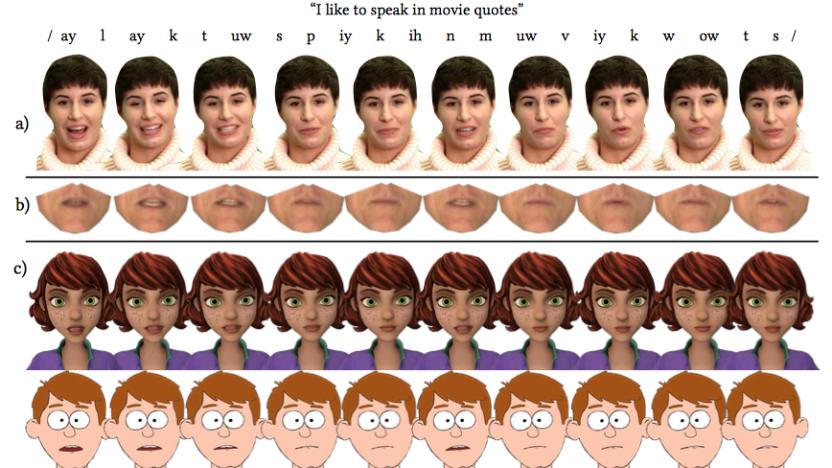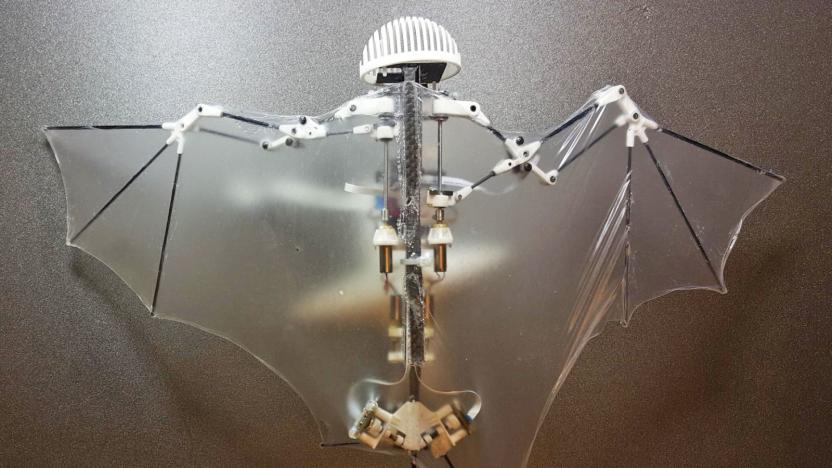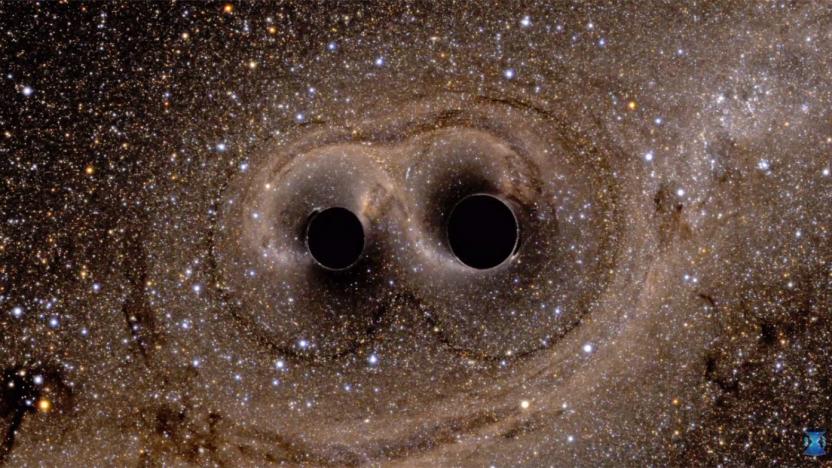Caltech
Latest

Researchers develop method for real-time speech animation
Researchers at the University of East Anglia, Caltech, Carnegie Mellon University and Disney have created a way to animate speech in real-time. With their method, rather than having skilled animators manually match an animated character's mouth to recorded speech, new dialogue can be incorporated automatically in much less time with a lot less effort.

Saturn's largest moon has enough energy to run a colony
Saturn's biggest moon, Titan, is one of the few viable places humans can explore first-hand beyond Mars. It's relatively safe from radiation, it's covered in liquid (though not water) and otherwise relatively safe. But could more than a handful of people even stay there for very long? Apparently, the answer is yes. Researchers have conducted a study showing that Titan should have enough energy to sustain a colony. The first arrivals might have to build a nuclear power plant and take advantage of radioactive decay, but colonists could use the abundance of hydrocarbon lakes to generate power by combining hydrogen with acetylene (which should also be plentiful). And since Saturn creates strong tides, you could use turbines to generate plenty of electricity.

Caltech's 'lensless camera' could make our phones truly flat
Even as our phones get thinner, there's one spot that keeps sticking out: the camera lens. Taking good pictures and being able to focus at multiple distances requires a layer of glass that's a certain size, but there's really no getting around it -- or is there? Researchers at Caltech have devised (PDF) an "optical phased array" chip that uses math as a substitute for a lens. By adding a time delay -- down to a quadrillionth of a second -- to the light received at different locations on the chip, it can change focus without a lens.

Bat Bot is an autonomous drone that mimics a bat's flight
For roboticists working in the field of biomimetics, copying a bat's complex flight patterns has been a difficult problem to solve. Or, as Caltech professor and Jet Propulsion Laboratory researcher Soon-Jo Chung put it during a press conference, "bat flight is the holy grail of aerial robotics." And according to a new research paper published by Chung and his JPL colleagues in the journal Science Robotics this week, that holy grail has officially been discovered.

Researchers figure out trick to a fruit fly's acrobatic flight
If you've ever tried to swat a fruit fly out of the air, you know how crafty the little buggers can be at avoiding your swings. Turns out that not only are they incredibly agile, they're super efficient as well, using only 12 muscles (each controlled by a single neuron) to propel itself through the air. And, thanks to the efforts of a team at CalTech, we know why these flies are so nimble. It's all in the muscles.

Caltech fires up LIGO to hunt for more gravitational waves
Nearly a year after LIGO, the Laser Interferometer Gravitational-wave Observatory, made physics history this past February, Caltech researchers have finally finished upgrading its capabilities and are ready to resume their hunt for gravitational waves. The system transitioned from experimental runs to regular operations on Wednesday morning, November 30th.

Caltech scientists make Van Gogh painting out of DNA origami
Art recreated in miniature is oddly compelling, requiring precision and a lot of patience. Caltech scientists have taken their own stab at it and recreated Vincent van Gogh's classic The Starry Night at about the width of a dime, but with their own science twist: they made it with delicately-wrapped genetic strands in a process known as DNA origami.

Molecules in space may show how life formed on Earth
Scientists have known for a while that the molecular ingredients of life can be found in nearby comets and meteorites, but it's now clear that those building blocks exist much, much further away from home. A research team has used spectral analysis to discover evidence of organic chiral molecules, the "mirror-image" molecules that are key to biology as we know it, in the Sagittarius B2 cloud near the heart of the Milky Way. This doesn't meant that life is forming in space, but it does suggest that the necessary molecular properties can appear in space first and transfer to planets through meteorite impacts.

Apple faces Caltech lawsuit over WiFi patents
Apple's legal troubles with schools aren't over yet: Caltech has sued Apple and chipmaker Broadcom for allegedly violating four WiFi-related patents. Supposedly, most Apple devices (including the iPhone, iPad, Mac and Apple Watch) from the iPhone 5 onward use Broadcom chips that copy Caltech decoding and encoding technology to improve data flow. As with most such lawsuits, the institute is calling for both damages and a ban on offending hardware.

Science confirms that gravitational waves exist
At last, scientists have validated a key part of Einstein's general theory of relativity. The National Science Foundation, Caltech and MIT have confirmed the existence of gravitational waves, or ripples in spacetime. Their two LIGO (Laser Interferometer Gravitational-wave Observatory) detectors measured atomic-scale differences on September 14th, 2015 that point to the collision of black holes (also a new discovery) 1.3 billion years ago, triggering gravity ripples that only just reached Earth. There have long been hints of these waves, but hard evidence has proven elusive until now.

Diatoms are a biological wonder material, new study says
Caltech professor Julia Greer and her team have taken a really close look at diatoms and found them to be tougher and more resilient than previously thought. Diatoms are single-celled, mostly microscopic algae encased in hard shells made of silica called "frustules." To figure out just how durable they really are, Greer and her team made beams out of frustules and conducted three-point bending experiments on them. According to their tests, it has the highest specific strength among all known biological materials. In other words, it has higher strength-to-weight ratio than bones, teeth and even antlers, all of which are known for being sturdy.

The farthest known galaxy is 13.2 billion years old
Scientists have long reckoned that the first galaxies came into being roughly 500 million to 1 billion years after the Big Bang, but finding these ancient celestial bodies is tricky when their light is so faint that even many specialized tools aren't up to the job. However, researchers have managed to spot a galaxy so old that it's making them question the established timeline for the universe. They've determined that the recently discovered EGS8p7 galaxy is a whopping 13.2 billion years old, making it both the farthest known galaxy to date and just 600 million years younger than the universe as we know it. Theoretically, it shouldn't be possible to see the galaxy at all -- in EGS8p7's era, space was supposed to be full of neutral hydrogen clouds that absorbed radiation and made galaxies invisible to later observers.

ICYMI: Ramen by drone, creepy robot gloves and the week in sum
#fivemin-widget-blogsmith-image-45672{display:none;} .cke_show_borders #fivemin-widget-blogsmith-image-45672, #postcontentcontainer #fivemin-widget-blogsmith-image-45672{width:570px;display:block;} try{document.getElementById("fivemin-widget-blogsmith-image-45672").style.display="none";}catch(e){}Today on In Case You Missed It: A Caltech research team is studying a species of jellyfish to see if its ability to rearrange limbs when injured could be used by the robots of the future; a Harvard glove prototype could restore gripping abilities in people with disabilities, but man is it the creepiest, alien-looking glove we've ever seen. We're also including a great video of a ramen-making machine that has optional drone delivery; at which point we call bulls**t.

Rearranging jellyfish limbs may lead to self-healing robots
Normally when a jellyfish loses a limb, say to the jaws of a hungry sea turtle, it simply regenerates the lost appendage, no big deal. However, a Caltech research team has been studying a certain jellyfish species that doesn't regrow its limbs but rather rearranges the remaining ones to maintain symmetry. They think that this body-modifying trick could one day help robots repair themselves after similar injuries.

Brain implants control robot arm well enough to grab a beer
A paralyzed man named Erik Sorto has finally been able to drink beer on his own after 13 years, and it's all thanks to a robotic arm controlled solely by his mind. If you've been following our robotics coverage, you'll know it isn't the first mind-controlled robo limb -- a DARPA-funded project once allowed a woman to feed herself chocolate, while the one developed by the Braingate2 consortium helped another woman drink coffee on her own. This particular technology, however, works quite differently from the others. Its creators, a team of researchers from various institutes led by Caltech, implanted the neural chips needed to control the arm into a part of the brain called "posterior parietal cortex" or PPC.

Radio telescope array could unlock the secrets of the early universe
To capture the night sky and better understand the formative years of our universe, astronomers are using something a tad more powerful than a traditional telescope. The Owens Valley Long Wavelength Array (OV-LWA) leverages 250 radio antennas, spread over a desert area equivalent to 450 football fields, to detect slender radio signals produced by distant pulsars, solar flares and auroras. Together, this army of antennas can capture the entire sky simultaneously and feed the resulting data back to the Owens Valley Radio Observatory. With over 25 terabytes flowing in every day, astronomers can study space weather, such as auroras, which occur when stars release magnetic energy.

Caltech wants to equip phones with built-in 3D scanners
Wouldn't it be great if we can use phones to 3D scan every day objects for printing? A research team from Caltech has designed a cheap and tiny camera chip that could make that happen. Even better, the team claims it can take 3D scans so precise, it could lead to "replica[s] accurate to within microns of the original object[s]." The silicon chip called nanophotonic coherent imager (NCI) is less than a millimeter square, so it can fit within actual phones or cameras without the need for extra hardware. It can capture an object's height, depth and width using tiny LIDARs that immerse an object in laser beams. The light that bounces off the object is then analyzed to determine its size and other details.

Surge the rescue robot is RoboSimian's more evolved sibling
It looks like the NASA Jet Propulsion Laboratory team responsible for RoboSimian's existence has been busy this year, creating its possible substitute for the DARPA Robotics Challenge finale. The result? A robot that stands upright at 4.5 feet and weighs in at 200 pounds called Surrogate, or Surge for short. It's more human-like than its predecessor, with its two arms, a head and a spine, which allows it to manipulate objects better. It also has Light Detection and Ranging (LiDAR) equipment on its head, which gives it the capability to create 3D maps of various locations using laser beams. Problem is, it can't climb rough or tall terrain, because it uses caterpillar tracks. Plus, its body only has room for one set of cameras.

Physics' best-known lectures are now available to everyone on the web
Ask professors about important physics lectures, and they'll probably point you toward Richard Feynman's famous 1964 talks. They led to one of the most popular physics books ever (over 1.5 million English copies sold) and helped generations understand concepts like quantum mechanics. They've been available to the public for a few years now, but there hasn't been an easy, legal way to read them online... until now, that is. The California Institute of Technology has finished publishing Feynman's lectures in a free, HTML5-based viewer that lets you read on any device with a modern web browser. Even the equations and diagrams are visible on small screens. You're sadly not allowed to grab offline copies, but these web versions may be perfect for brushing up on the fundamentals of energy and matter before a big test -- even if you have to study on your smartphone. [Image credit: Associated Press]

Researchers turn standard microscope into billion-pixel imaging beast
A team of researchers at the California Institute of Technology, led by Professor Changhuei Yang, have figured out a way to crank their microscopy up to 11. Usually, scientists are forced between a rock and a hard place: they can have high res images of small areas or low resolution pictures of larger fields. Using a strategy known as Fourier ptychographic microscopy, Yang's team was able to computationally correct a standard microscope's low res imagery, producing a billion-pixel picture. By adding an LED array to an existing microscope -- the only hardware tweak their $200 system calls for -- the researchers were able to stitch together a 20X quality image from a 2X optical lens. The information gleaned from the LED lights was corrected entirely on a computer, making it an exceptionally cost effective way to create high res microscopic images. The team's report, published by the journal Nature Phototonics, can be read in full at the source link below.








